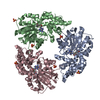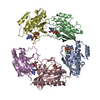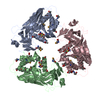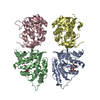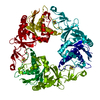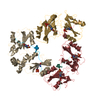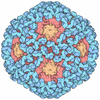[English] 日本語
 Yorodumi
Yorodumi- SASDBD7: Human Proliferating Cell Nuclear Antigen (PCNA) (Proliferating ce... -
+ Open data
Open data
- Basic information
Basic information
| Entry | Database: SASBDB / ID: SASDBD7 |
|---|---|
 Sample Sample | Human Proliferating Cell Nuclear Antigen (PCNA)
|
| Function / homology |  Function and homology information Function and homology informationpositive regulation of deoxyribonuclease activity / dinucleotide insertion or deletion binding / PCNA-p21 complex / mitotic telomere maintenance via semi-conservative replication / purine-specific mismatch base pair DNA N-glycosylase activity / nuclear lamina / positive regulation of DNA-directed DNA polymerase activity / Polymerase switching / MutLalpha complex binding / Telomere C-strand (Lagging Strand) Synthesis ...positive regulation of deoxyribonuclease activity / dinucleotide insertion or deletion binding / PCNA-p21 complex / mitotic telomere maintenance via semi-conservative replication / purine-specific mismatch base pair DNA N-glycosylase activity / nuclear lamina / positive regulation of DNA-directed DNA polymerase activity / Polymerase switching / MutLalpha complex binding / Telomere C-strand (Lagging Strand) Synthesis / Processive synthesis on the lagging strand / PCNA complex / Removal of the Flap Intermediate / Processive synthesis on the C-strand of the telomere / Polymerase switching on the C-strand of the telomere / Mismatch repair (MMR) directed by MSH2:MSH3 (MutSbeta) / Mismatch repair (MMR) directed by MSH2:MSH6 (MutSalpha) / Transcription of E2F targets under negative control by DREAM complex / Removal of the Flap Intermediate from the C-strand / replisome / response to L-glutamate / response to dexamethasone / histone acetyltransferase binding / DNA polymerase processivity factor activity / leading strand elongation / G1/S-Specific Transcription / nuclear replication fork / replication fork processing / SUMOylation of DNA replication proteins / PCNA-Dependent Long Patch Base Excision Repair / response to cadmium ion / translesion synthesis / estrous cycle / mismatch repair / cyclin-dependent protein kinase holoenzyme complex / base-excision repair, gap-filling / DNA polymerase binding / liver regeneration / epithelial cell differentiation / positive regulation of DNA repair / TP53 Regulates Transcription of Genes Involved in G2 Cell Cycle Arrest / Translesion synthesis by REV1 / Translesion synthesis by POLK / Translesion synthesis by POLI / positive regulation of DNA replication / Gap-filling DNA repair synthesis and ligation in GG-NER / replication fork / nuclear estrogen receptor binding / male germ cell nucleus / Termination of translesion DNA synthesis / Recognition of DNA damage by PCNA-containing replication complex / Translesion Synthesis by POLH / receptor tyrosine kinase binding / HDR through Homologous Recombination (HRR) / Dual Incision in GG-NER / cellular response to xenobiotic stimulus / cellular response to hydrogen peroxide / Dual incision in TC-NER / Gap-filling DNA repair synthesis and ligation in TC-NER / cellular response to UV / response to estradiol / E3 ubiquitin ligases ubiquitinate target proteins / heart development / chromatin organization / damaged DNA binding / chromosome, telomeric region / nuclear body / centrosome / chromatin binding / chromatin / protein-containing complex binding / enzyme binding / negative regulation of transcription by RNA polymerase II / extracellular exosome / nucleoplasm / identical protein binding / nucleus Similarity search - Function |
| Biological species |  Homo sapiens (human) Homo sapiens (human) |
 Citation Citation |  Journal: Nucleic Acids Res / Year: 2017 Journal: Nucleic Acids Res / Year: 2017Title: Destabilization of the PCNA trimer mediated by its interaction with the NEIL1 DNA glycosylase. Authors: Aishwarya Prakash / Kedar Moharana / Susan S Wallace / Sylvie Doublié /  Abstract: The base excision repair (BER) pathway repairs oxidized lesions in the DNA that result from reactive oxygen species generated in cells. If left unrepaired, these damaged DNA bases can disrupt ...The base excision repair (BER) pathway repairs oxidized lesions in the DNA that result from reactive oxygen species generated in cells. If left unrepaired, these damaged DNA bases can disrupt cellular processes such as replication. NEIL1 is one of the 11 human DNA glycosylases that catalyze the first step of the BER pathway, i.e. recognition and excision of DNA lesions. NEIL1 interacts with essential replication proteins such as the ring-shaped homotrimeric proliferating cellular nuclear antigen (PCNA). We isolated a complex formed between NEIL1 and PCNA (±DNA) using size exclusion chromatography (SEC). This interaction was confirmed using native gel electrophoresis and mass spectrometry. Stokes radii measured by SEC hinted that PCNA in complex with NEIL1 (±DNA) was no longer a trimer. Height measurements and images obtained by atomic force microscopy also demonstrated the dissociation of the PCNA homotrimer in the presence of NEIL1 and DNA, while small-angle X-ray scattering analysis confirmed the NEIL1 mediated PCNA trimer dissociation and formation of a 1:1:1 NEIL1-DNA-PCNA(monomer) complex. Furthermore, ab initio shape reconstruction provides insights into the solution structure of this previously unreported complex. Together, these data point to a potential mechanistic switch between replication and BER. |
 Contact author Contact author |
|
- Structure visualization
Structure visualization
| Structure viewer | Molecule:  Molmil Molmil Jmol/JSmol Jmol/JSmol |
|---|
- Downloads & links
Downloads & links
-Data source
| SASBDB page |  SASDBD7 SASDBD7 |
|---|
-Related structure data
| Related structure data | C: citing same article ( |
|---|---|
| Similar structure data |
- External links
External links
| Related items in Molecule of the Month |
|---|
-Models
| Model #808 |  Type: dummy / Software: GASBOR / Radius of dummy atoms: 1.90 A / Chi-square value: 0.75  Search similar-shape structures of this assembly by Omokage search (details) Search similar-shape structures of this assembly by Omokage search (details) |
|---|
- Sample
Sample
 Sample Sample | Name: Human Proliferating Cell Nuclear Antigen (PCNA) / Specimen concentration: 1.00-6.00 |
|---|---|
| Buffer | Name: 25mM HEPES 100mM NaCl 1mM DTT / pH: 7.5 |
| Entity #452 | Type: protein / Description: Proliferating cell nuclear antigen / Formula weight: 29.669 / Num. of mol.: 3 / Source: Homo sapiens / References: UniProt: P12004 Sequence: MHHHHHHMFE ARLVQGSILK KVLEALKDLI NEACWDISSS GVNLQSMDSS HVSLVQLTLR SEGFDTYRCD RNLAMGVNLT SMSKILKCAG NEDIITLRAE DNADTLALVF EAPNQEKVSD YEMKLMDLDV EQLGIPEQEY SCVVKMPSGE FACICRDLSH IGDAVVISCA ...Sequence: MHHHHHHMFE ARLVQGSILK KVLEALKDLI NEACWDISSS GVNLQSMDSS HVSLVQLTLR SEGFDTYRCD RNLAMGVNLT SMSKILKCAG NEDIITLRAE DNADTLALVF EAPNQEKVSD YEMKLMDLDV EQLGIPEQEY SCVVKMPSGE FACICRDLSH IGDAVVISCA KDGVKFSASG ELGNGNIKLS QTSNVDKEEE AVTIEMNEPV QLTFALRYLN FFTKATPLSS TVTLSMSADV PLVVEYKIAD MGHLKYYLAP KIEDEEGS |
-Experimental information
| Beam | Instrument name: Advanced Light Source (ALS) 12.3.1 (SIBYLS) City: Berkeley, CA / 国: USA  / Type of source: X-ray synchrotron / Wavelength: 0.1127 Å / Dist. spec. to detc.: 1.4 mm / Type of source: X-ray synchrotron / Wavelength: 0.1127 Å / Dist. spec. to detc.: 1.4 mm | ||||||||||||||||||||||||||||||||||||
|---|---|---|---|---|---|---|---|---|---|---|---|---|---|---|---|---|---|---|---|---|---|---|---|---|---|---|---|---|---|---|---|---|---|---|---|---|---|
| Detector | Name: Pilatus3 X 2M / Pixsize x: 172 mm | ||||||||||||||||||||||||||||||||||||
| Scan |
| ||||||||||||||||||||||||||||||||||||
| Distance distribution function P(R) |
| ||||||||||||||||||||||||||||||||||||
| Result | Comments: Experimental MW reported here is from SAXSMoW. PCNA was used to calibrate forward intensity for MW estimation of other scatterers.
|
 Movie
Movie Controller
Controller



